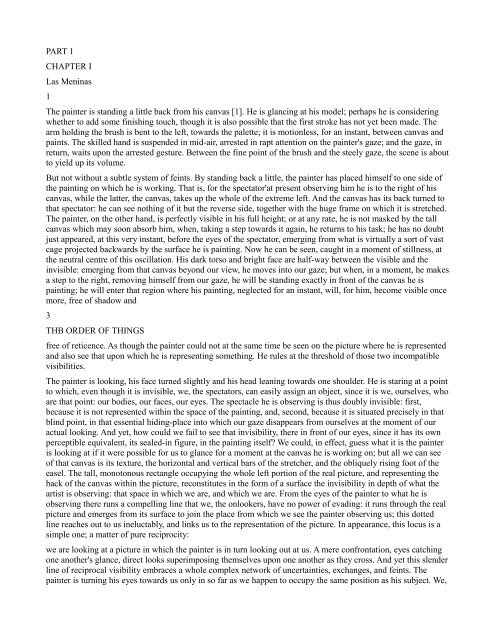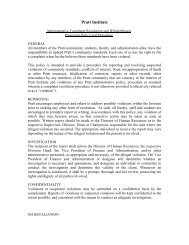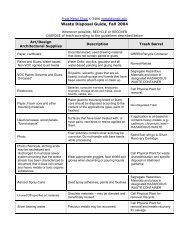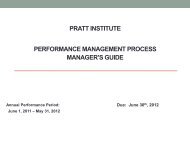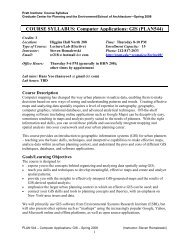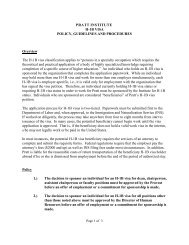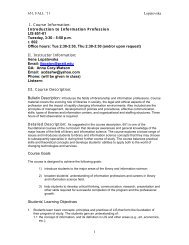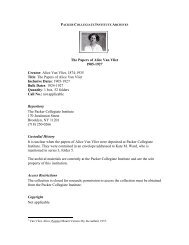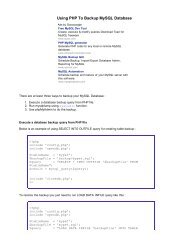Michel Foucault, THE ORDER OF THINGS An Archeology of the ...
Michel Foucault, THE ORDER OF THINGS An Archeology of the ...
Michel Foucault, THE ORDER OF THINGS An Archeology of the ...
You also want an ePaper? Increase the reach of your titles
YUMPU automatically turns print PDFs into web optimized ePapers that Google loves.
PART 1<br />
CHAPTER I<br />
Las Meninas<br />
1<br />
The painter is standing a little back from his canvas [1]. He is glancing at his model; perhaps he is considering<br />
whe<strong>the</strong>r to add some finishing touch, though it is also possible that <strong>the</strong> first stroke has not yet been made. The<br />
arm holding <strong>the</strong> brush is bent to <strong>the</strong> left, towards <strong>the</strong> palette; it is motionless, for an instant, between canvas and<br />
paints. The skilled hand is suspended in mid-air, arrested in rapt attention on <strong>the</strong> painter's gaze; and <strong>the</strong> gaze, in<br />
return, waits upon <strong>the</strong> arrested gesture. Between <strong>the</strong> fine point <strong>of</strong> <strong>the</strong> brush and <strong>the</strong> steely gaze, <strong>the</strong> scene is about<br />
to yield up its volume.<br />
But not without a subtle system <strong>of</strong> feints. By standing back a little, <strong>the</strong> painter has placed himself to one side <strong>of</strong><br />
<strong>the</strong> painting on which he is working. That is, for <strong>the</strong> spectator'at present observing him he is to <strong>the</strong> right <strong>of</strong> his<br />
canvas, while <strong>the</strong> latter, <strong>the</strong> canvas, takes up <strong>the</strong> whole <strong>of</strong> <strong>the</strong> extreme left. <strong>An</strong>d <strong>the</strong> canvas has its back turned to<br />
that spectator: he can see nothing <strong>of</strong> it but <strong>the</strong> reverse side, toge<strong>the</strong>r with <strong>the</strong> huge frame on which it is stretched.<br />
The painter, on <strong>the</strong> o<strong>the</strong>r hand, is perfectly visible in his full height; or at any rate, he is not masked by <strong>the</strong> tall<br />
canvas which may soon absorb him, when, taking a step towards it again, he returns to his task; he has no doubt<br />
just appeared, at this very instant, before <strong>the</strong> eyes <strong>of</strong> <strong>the</strong> spectator, emerging from what is virtually a sort <strong>of</strong> vast<br />
cage projected backwards by <strong>the</strong> surface he is painting. Now he can be seen, caught in a moment <strong>of</strong> stillness, at<br />
<strong>the</strong> neutral centre <strong>of</strong> this oscillation. His dark torso and bright face are half-way between <strong>the</strong> visible and <strong>the</strong><br />
invisible: emerging from that canvas beyond our view, he moves into our gaze; but when, in a moment, he makes<br />
a step to <strong>the</strong> right, removing himself from our gaze, he will be standing exactly in front <strong>of</strong> <strong>the</strong> canvas he is<br />
painting; he will enter that region where his painting, neglected for an instant, will, for him, become visible once<br />
more, free <strong>of</strong> shadow and<br />
3<br />
THB <strong>ORDER</strong> <strong>OF</strong> <strong>THINGS</strong><br />
free <strong>of</strong> reticence. As though <strong>the</strong> painter could not at <strong>the</strong> same time be seen on <strong>the</strong> picture where he is represented<br />
and also see that upon which he is representing something. He rules at <strong>the</strong> threshold <strong>of</strong> those two incompatible<br />
visibilities.<br />
The painter is looking, his face turned slightly and his head leaning towards one shoulder. He is staring at a point<br />
to which, even though it is invisible, we, <strong>the</strong> spectators, can easily assign an object, since it is we, ourselves, who<br />
are that point: our bodies, our faces, our eyes. The spectacle he is observing is thus doubly invisible: first,<br />
because it is not represented within <strong>the</strong> space <strong>of</strong> <strong>the</strong> painting, and, second, because it is situated precisely in that<br />
blind point, in that essential hiding-place into which our gaze disappears from ourselves at <strong>the</strong> moment <strong>of</strong> our<br />
actual looking. <strong>An</strong>d yet, how could we fail to see that invisibility, <strong>the</strong>re in front <strong>of</strong> our eyes, since it has its own<br />
perceptible equivalent, its sealed-in figure, in <strong>the</strong> painting itself? We could, in effect, guess what it is <strong>the</strong> painter<br />
is looking at if it were possible for us to glance for a moment at <strong>the</strong> canvas he is working on; but all we can see<br />
<strong>of</strong> that canvas is its texture, <strong>the</strong> horizontal and vertical bars <strong>of</strong> <strong>the</strong> stretcher, and <strong>the</strong> obliquely rising foot <strong>of</strong> <strong>the</strong><br />
easel. The tall, monotonous rectangle occupying <strong>the</strong> whole left portion <strong>of</strong> <strong>the</strong> real picture, and representing <strong>the</strong><br />
back <strong>of</strong> <strong>the</strong> canvas within <strong>the</strong> picture, reconstitutes in <strong>the</strong> form <strong>of</strong> a surface <strong>the</strong> invisibility in depth <strong>of</strong> what <strong>the</strong><br />
artist is observing: that space in which we are, and which we are. From <strong>the</strong> eyes <strong>of</strong> <strong>the</strong> painter to what he is<br />
observing <strong>the</strong>re runs a compelling line that we, <strong>the</strong> onlookers, have no power <strong>of</strong> evading: it runs through <strong>the</strong> real<br />
picture and emerges from its surface to join <strong>the</strong> place from which we see <strong>the</strong> painter observing us; this dotted<br />
line reaches out to us ineluctably, and links us to <strong>the</strong> representation <strong>of</strong> <strong>the</strong> picture. In appearance, this locus is a<br />
simple one; a matter <strong>of</strong> pure reciprocity:<br />
we are looking at a picture in which <strong>the</strong> painter is in turn looking out at us. A mere confrontation, eyes catching<br />
one ano<strong>the</strong>r's glance, direct looks superimposing <strong>the</strong>mselves upon one ano<strong>the</strong>r as <strong>the</strong>y cross. <strong>An</strong>d yet this slender<br />
line <strong>of</strong> reciprocal visibility embraces a whole complex network <strong>of</strong> uncertainties, exchanges, and feints. The<br />
painter is turning his eyes towards us only in so far as we happen to occupy <strong>the</strong> same position as his subject. We,


